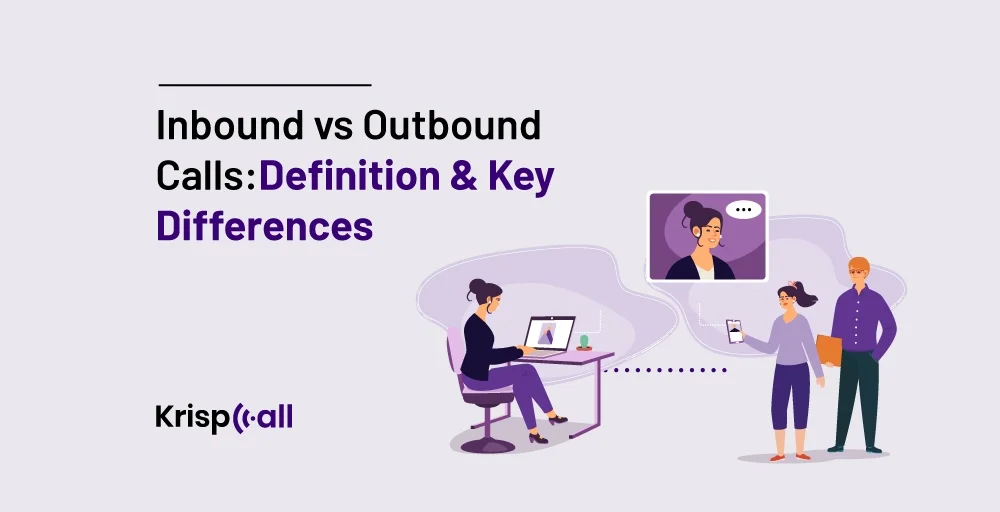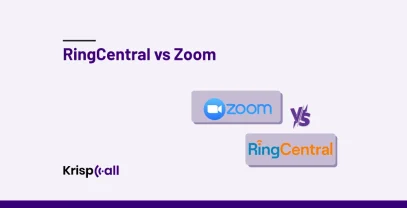There is no doubt 🥳 that inbound and outbound phone calls📳 play a huge role in customer service. Inbound calls mean customers reaching out to businesses, while outbound calls mean businesses reaching out to customers. So, what’s the difference between them, and which is better for your business?
In this blog, we’ll guide you through the inbound vs outbound calls including their definitions and key differences, which will help you make informed business decisions.
So, let’s get started.
🔑 KEY HIGHLIGHTS
- An inbound call is one where the customer calls a call center or business whereas an outbound call is the one where the call center or businesses call a customer.
- Inbound calls help to build customer loyalty, improve retention, and provide excellent service.
- Outbound calls help promote products or services, generate sales, and convert prospects into customers.
What are inbound calls?

Inbound calls are calls a business receives from prospects or customers regarding products or services. An inbound call is when a customer calls a call center or business. Sometimes, employees call a support desk, too, but that’s not an inbound call. An inbound call means calls from customers and potential customers.
Most inbound calls are related to customer service, but they can also be related to sales or marketing. An inbound call center generally manages inbound/incoming calls. The inbound call center’s primary goal is to provide great customer service by answering questions, solving problems, and addressing concerns.
For example, when a customer calls a business to inquire about product availability or request information about a service, it is an inbound call.
What are outbound calls?

Outbound calls are the ones that an employee places to customers on the company’s behalf. The purpose of outbound calls is typically sales, lead generation, telemarketing, or other outreach efforts by the company. The aim is to reach new customers for sales, lead generation, fundraising, and telemarketing.
In a business, outbound calls are made more than inbound calls. Sales reps use lists of current or potential customers to make cold calls, pitch sales, and help customers upgrade their services.
For example, when a sales rep calls potential customers to promote products or services and try to make sales, it is an outbound call.
Inbound vs outbound Calls: What is the difference?
Inbound calls are those initiated by customers or potential customers seeking help, information, or support. This typically happens for customer service, technical support, placing orders, or general inquiries. These calls are crucial for building customer loyalty, improving retention, and providing excellent service. They allow companies to address existing customer needs and strengthen relationships.
On the other hand, outbound calls are those initiated by company employees to leads or prospects. The purpose of outbound calls can be sales pitches, appointment setting, market research, or following up with existing customers. This approach aims to promote products or services, generate sales, and convert prospects into customers.
Types of inbound calls
Some types of inbound calls are:
1. Customer service
Here, current customers make inbound calls with questions or concerns or to manage their accounts. These calls may be related to returns calls, feedback, payments, address updates, and inquiries about policies.
2. Technical support
Here, customers make inbound calls when they face technical issues or things aren’t going well, like a computer that won’t turn on. These calls are usually made by unhappy customers; therefore, technical support staff needs to be patient and should be able to handle customer complaints.
3. Inbound Sales
Sometimes, potential buyers initiate inbound calls seeking information about a company’s products or services. This presents an opportunity for businesses to convert them into buyers. As part of an inbound sales call, the representative should establish common ground with the prospect, provide useful information, and be transparent to gain the prospect’s trust.
4. Upgrade and Renewal Inquiry Calls
These inbound calls are made when customers want to renew, upgrade, or change their subscription plans. Usually, these customers are happy with the service and want to keep being involved with the company.
Types of businesses that use inbound calling
Some types of businesses that use inbound calling are:
- Healthcare industry: The healthcare industry uses inbound calls for appointments, medical inquiries, and emergency services. Whereas, patients use them to schedule appointments, resolve queries about medical conditions or prescriptions, or in emergencies.
- Customer service centers: Customer service centers use inbound calling to handle incoming calls from customers regarding product inquiries, complaints, technical support, and more.
- Financial Institutions: Inbound calling is useful for financial institutions for customer support, account management, and fraud prevention. Likewise, customers use it to check their balances, report lost or stolen cards, inquire about loans or mortgages, etc.
- Hospitality industry: The hospitality industry uses inbound calling to confirm reservations, provide customer assistance, and more. Customers also use it to make reservations and inquire about room rates, amenities, and special packages.
Types of outbound calls
Here are some of the types of outbound calls:
1. Appointment setting
In this type of outbound call, businesses call potential or existing customers to schedule appointments, consultations, or meetings. Here, sales agents call prospects or clients and arrange face-to-face meetings, phone consultations for sales meetings, service consultations, or product demonstrations.
2. Lead generation
Inbound calls are also made to generate leads, which involve reaching out to potential customers to identify and qualify prospects. The sales professional calls the potential customers to gather information, sell their products or services, and gain their trust.
3. Telemarketing
It involves making outbound calls to potential customers to promote products, services, or special offers. Telemarketers call the targeted customers to introduce their products or services, highlight benefits, and convince them to make a purchase.
4. Market research
In market research, inbound calling is done to individuals or businesses to gather information about market trends, consumer preferences, or product feedback. The researchers call individuals or businesses to conduct surveys, gather opinions, or collect data on specific topics.
Types of businesses that use outbound calling
Different types of businesses make outbound calls. Some of these are:
- Insurance Companies: Insurance companies make outbound calls to connect with potential customers. Through inbound calls, they offer insurance policies, provide quotes, and discuss coverage options.
- Software and Technology Companies: Software and technology companies make outbound calls as part of their sales and customer support strategies. They make calls to offer software solutions, upgrades, training services, etc.
- Educational Institutions: Educational institutions use outbound calls for recruitment purposes. They can reach out to prospective students to provide information about program admissions, follow up with applicants, schedule campus tours, etc.
- Nonprofit Organizations: These organizations use outbound calling to raise funds, reach out to donors, provide updates on ongoing projects, or thank supporters. Outbound calling can also be used to recruit volunteers, promote events, or conduct surveys to gather feedback from stakeholders.
Inbound vs Outbound Calls: Which is better for your business?
When deciding between inbound and outbound calls for your business, you need to focus on your specific requirements and challenges. For instance, if your business is struggling to manage a high volume of tech support and customer care calls, you should choose inbound calls. Likewise, if your business finds it difficult to follow up on a long list of leads, choosing outbound calls makes more sense.
Strategically making inbound and outbound calls helps in the appropriate stages of your business’s growth. It helps to address your specific needs effectively.
Regardless of the type of calls selected, it is important to have the right inbound call center software and outbound call center software for efficient operations. One of the best software you can try to make outbound and inbound calls is KrispCall. It is a cloud telephony system that offers several call management features to handle large volumes of incoming and outgoing calls effectively. These features include call forwarding, call transfer, IVR, auto attendant, call filter, call queuing, etc.





